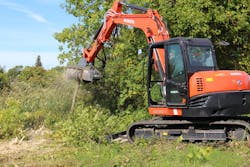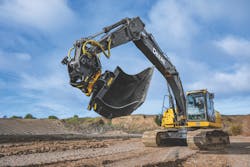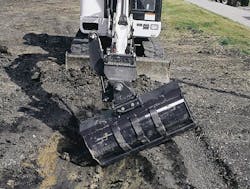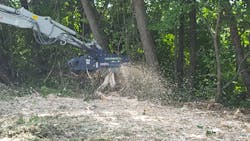Add-ons have always been an important feature of heavy earth moving equipment. They allow an operator to turn a relatively small number of machines into a larger fleet with multiple capabilities at minimal costs. Even more important is an add-on that allows for more effective use of other add-ons. Operators are used to changing out excavator buckets, rock hammers and drillers, dozer blades and blading buckets. But there are other attachments for these attachments that greatly improve their productivity and usefulness. One of these is a tiltrotator.
Think of a tiltrotator (also known as a Rotortilt) as you would a human wrist, only far more versatile and flexible. A tiltrotator is a flexible connection between an excavator’s arm the bucket or other attachments such as a breaker, grapple, or an auger. Control is delivered through two or four hydraulic power lines. It comes in a wide variety of sizes ranging from 1.5 tons to 40 tons and allows the attachment to tilt up to plus or minus 45 degrees (effectively a swing of 90 degrees) and rotate 360 degrees. The machine can become a true analog of the human hand by attaching a grappler to allow for bulk material handling or as a tool carrier. A recent innovation is the use of a quick coupler which allows the operator to detach and change out attachments without having to leave his operator's cab. Using a tiltrotator can increase the efficacy of a machine by as much as 35%. Flexibility and agility are the keys to this improvement, especially on tight job sites with minimal room to operate or maneuver. The tiltrotator has a built-in gripping mechanism called a "pincher" or "grab" which allows for easy pipe laying and moving materials across a job site. The use of a tilting mechanism on a grade-all excavator arm is why a contractor can easily excavate a perfect v-trench with a bucket having a flat bottom edge. The tiltrotator attachment gives this capability to smaller excavators and other machines.
First gaining wide use in the Scandinavian countries, it was introduced in the 1980s by a company called Noreco to the Swedish market (apparently, not everything made in Sweden needs an Allen wrench). Its use has spread to European and overseas markets such as Canada, the United States, Japan, the United Kingdom, Germany, and the Netherlands. New control systems allow for complete control by the operator via joysticks. Standard control systems include SVAB, ICS by Rototilt, Engcon Microprop DC2, and Steelwrist XControl G2.
However, tiltrotators by themselves would not be able to effectively deliver all other potential benefits. Two other technologies, symmetrical quick (SQ) attachments and machined control systems (MCS) are needed to fully exploit the potential of the tiltrotator.
SQ Technology
SQ stands for “Symmetrical Quick Attachments for Excavators.” It is an open industry standard created, managed, and enforced by the Swedish Machine Suppliers Association. With SQ technology, an operator can connect and disconnect hydraulic attachments without ever leaving the comfort of his cab. With this auxiliary function, the operator can connect a multitude of hydraulic tools to his tiltrotator (sweepers, grapples, vibratory plate compactors, etc.). The entire change-out operation can take place in less than a minute. This technology is not just limited to tiltrotators. It is now used by wheel loaders, excavators, and skid-steers. “New users of fully automatic couplers can see benefits fast and the payback time for the investment is relatively short,” says Christian Yanes, president/country manager at Steelwrist. These benefits include:
- Less maintenance on the attachments—you are using the attachment in the way it is supposed to be used, and the right tool for the task
- Fewer machines onsite
- Fewer transportation costs for machines and attachments
- No oil spill when changing attachments (environmentally friendly)
- Less transportation damage on attachments (hoses)
- No long, hanging hoses to get stuck in rebar (very low hose counts)
- Fewer worksite accidents (less time outside machine's cab)
There are several reasons why symmetrical quick couplers are the fastest-growing type of quick couplers in the world. Lightweight, versatile yet ruggedly built they are also comparatively inexpensive compared to other international standards. They ensure that the right tool is used for the right job.
What does this mean for the job site? First and most important of all is an increase in safety. When an operator can stay in the cab and not have to go outside to manually wrestle a new attachment onto his tiltrotator, he is less exposed to equipment and vehicle traffic, as well as other site hazards and nuisances. Getting out of the cab and manually attaching a new tool takes time, a time when the equipment and the operator are both idle in the sense that they are not performing needed earthwork operations. As such, SQ technology greatly (if indirectly) increases overall site productivity.
Machine Control Systems (MCS)
But what controls the intricate movements of the tiltrotator? Increasingly, tiltrotators are being operated with machine control systems (MCS). With feedback from the tiltrotator's rotation sensor, these signals can be fed back to the machine control system which then generates a three-dimensional picture of the tool’s location and position. Its European patent describes it as such: “A control system for controlling a tiltrotator comprises control means, a controller, a feeder pilot, a feeder, and a plurality of external proportional valves for controlling the movements of the tiltrotator. The control system further comprises an inclinometer providing to the controller the orientation of a tool attached to the tiltrotator.”
Manual operation via the machine control system is performed with something any video gamer would recognize: an ergonomic joystick. With his joystick, an equipment operator can effectively control all of the tiltrotator's functions, movements, and positions. Feedback allows the system to automatically calibrate the valves operating the hydraulic system that acutely moves the tiltrotator. Automatic tilting and full position feedback make the operator’s job that much easier. Similarly, automatic calibration of the hydraulic valves optimizes feedback and minimizes fuel use. High precision joystick rollers provide smooth movement and high precision.
The machine control system's visual display screen allows the operator to see exactly how the tiltrotator and its attached tool system are located, moving, and rotating in real-time. Auto tilt ties the movement of the tiltrotator and its attachments to three-dimensional maps of the worksite. This greatly improves efficiency while reducing costs.
Major Suppliers
Loftness is a 100% employee-owned company based in Hector, MN, where it manufactures the VM Logix line of vegetation management equipment. Its product line includes hydraulic oil coolers, the Kwik-Trim compact mechanical tree trimmer, a disc mulcher, and high-performance horizontal drum mulchers for a variety of equipment, ranging from excavators, skid-steer loaders, and up to 400 hp prime movers. For more information, visit loftness.com.
Due to high customer demand, Loftness has been working on expanding its offering of Battle Ax mulching attachments for excavators. As a result, Loftness now offers a 20, 30, 40, and 50 series of the Battle Ax designed for excavators anywhere from 10,000 to 88,000 pounds. What makes the new Battle Ax unique is the rotor design, which uses built-in depth gauges. These depth gauges function like raker teeth on chain saws to prevent the attachment from engaging too much material at one time. This design is ideal for managing the amount of material being fed into the attachment compared with competitive ring-style rotors, which many operators find to be overly limiting. Another exclusive feature to the Battle Ax is a two-stage cutting chamber, which is capable of processing material more thoroughly than competitive units by cutting material twice. The primary shear bar is adjustable, so the clearance can be narrowed or widened depending upon the desired material size and production rate. From here, the partially reduced material passes smoothly to the secondary cutting chamber behind the front bumper, where it’s processed further before being discharged toward the ground.
Steelwrist is a Swedish company that has had a presence in the North American market since 2017. With headquarters for North America in Berlin, CT, Steelwrist is the fastest-growing tiltrotator manufacturer in the market, offering a quick coupler from 3,000-pound machines up to 140,000 pounds, and tiltrotators from 4,400 pounds up to 64,000-pound machines. Steelwrist offers the quick coupler and tiltrotator along with a wide portfolio of attachments to go with it. From grapples to grading beams, asphalt cutters, rippers, pallet forks, brushes, sweepers, hydraulic compactors, and many different styles of buckets. Steelwrist has the lowest building height and lowest weight in the market thanks to the fact that they cast in steel. They are the only manufacturer with a four-finger gripper and can offer Standard S and SQ technology that allows operators to pick up hydraulic attachments without having to exit the cab.
With Steelwrist SQ technology, an operator will be able to change between tiltrotator, hydraulic breaker, crusher, shear, pulverize, grapple, screening bucket, compactor, and of course any mechanical work tool, all without ever leaving the cabin and in only seconds. By using the latest available technology, it was possible to optimize the hydraulic characteristics as well as to drive cost down. This makes full hydraulic couplers more affordable than in the past with even improved oil flow characteristics. By maintaining the steel-casted one-piece body in both SQ-couplers and SQ-tiltrotators, they manage to keep the same exceptional strength/weight relationship as the other Steelwrist products. By using the Front Pin Lock technology on their SQ-couplers, the operator can manage to keep the high safety level without the need for complicated and expensive sensor-based control systems.
The Bobcat Company has for more than 60 years specialized in the manufacture of compact equipment that improves job site efficiency and effectiveness. High performance, rugged design, operator comfort, flexibility, and versatility have been the hallmark of their machines and attachments. Their high standards and innovation have made them the industry leader. Naturally, they would be a leader in the applications of tiltrotators and machine control systems to the job site.
Their Hydra-Tilt attachment allows an operator to smoothly and efficiently create slopes, grades, and contour. Its primary applications are to: create slopes in landscaping, cut or clean drainage ditches. grade and contour land, dig and shape holes, and dig around and under culverts, sewer lines, tree roots, and foundations. It is designed for compact excavators and maximizes productivity for bucket attachments. Powered by a hydraulic cylinder, the Hydra-Tilt attachment acts like a human wrist to allow the operator to angle the excavator bucket 30 degrees to the left or right (a total sweep of 60 degrees of tilt). With this flexibility, the Hydra-Tilt attachment can easily work carefully around pavements, foundations, buried utilities, and sewer pipelines.
Jason Simmons, attachments engineering supervisor at John Deere Construction and Forestry, provides several insights into new machine attachments: The demand for the integration of grade control solutions on compact machines and attachments has been accelerated over the last few years. Deere’s grade control solutions, in partnership with their full range of over 100 attachments, offer enhanced productivity features for nearly any job. In the past couple of years, Deere has seen an increase in demand for solutions that assist compact machines in achieving accurate grades, specifically with their Level Best Box Blades. There are three Level Best Box Blade models to choose from that help improve productivity for customers looking for a grading solution. Each model is available in 2D precision grading and 3D precision grading options and automatically adjusts the elevation by controlling the lift and tilt of the attachment to maintain vertical accuracy and smooth grading performance. These models also adjust dozens of times per second to ensure a smooth grade with tight tolerances, which is ideal for precision grading. Deere has also seen a lot of interest in their new dozer blade, which will be available on the SmartGrade 333G Compact Track Loader later this year. Their John Deere-designed and built, six-way dozer blade attachment can both cut a grade and spread materials, streamlining attachment needs and setup time. The blade is also fine-tuned to meet the performance needs of a compact track loader and does not require tools to change between other attachments. It also enhances the versatility of the machine by accurately and automatically cutting or finishing light materials in tight spaces. In conjunction with SmartGrade technology, the blade reduces the amount of operator input, ultimately lowering operator fatigue.
Justin Steger, solutions marketing manager, John Deere Construction & Forestry, has this to say specifically about tiltrotators: Tiltrotators have become increasingly more popular on the compact excavator and full-size excavator models over the past few years. In response to this demand, Deere recently announced a preferred supplier agreement with engcon. With the engcon tiltrotator solution, operators can rotate attachments 360 degrees and tilt up to 45 degrees side to side. Additionally, the tiltrotators feature the EC-Oil quick coupler system, which enables the operator to efficiently change attachments without leaving the cab. This all adds up to a more productive, versatile, and efficient solution for customers. Later this year, customers will have the ability to order engcon tiltrotators, EC oil couplers, and engcon attachments through their John Deere dealers. Tiltrotators can be fitted on 26G-350G LC models and EC oil couplers are compatible with 75G–350G LC machines.
From a machine side, Deere has begun to offer programable attachment modes in the monitor on some of Deere's most popular models, allowing operators to set and save the flows and pressures for their attachments on the go, making them even more efficient. In some cases, grade control technology can be paired with a tiltrotator, increasing capabilities on the job. More specifically, grade control technology is helpful while backfilling or completing finished grading work. Efficiencies presented by operating with grade control translates directly to increased productivity and bottom line, helping operators get more done with more precision, in less time.





